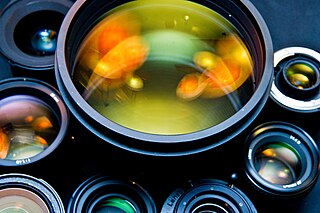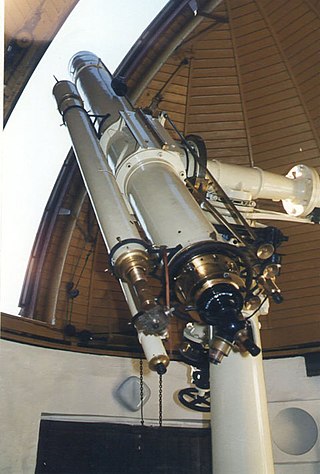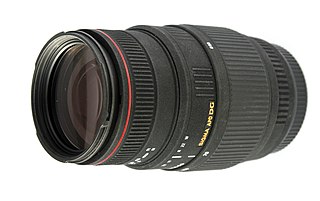
In optics, aberration is a property of optical systems, such as lenses, that causes light to be spread out over some region of space rather than focused to a point. Aberrations cause the image formed by a lens to be blurred or distorted, with the nature of the distortion depending on the type of aberration. Aberration can be defined as a departure of the performance of an optical system from the predictions of paraxial optics. In an imaging system, it occurs when light from one point of an object does not converge into a single point after transmission through the system. Aberrations occur because the simple paraxial theory is not a completely accurate model of the effect of an optical system on light, rather than due to flaws in the optical elements.

A lens is a transmissive optical device that focuses or disperses a light beam by means of refraction. A simple lens consists of a single piece of transparent material, while a compound lens consists of several simple lenses (elements), usually arranged along a common axis. Lenses are made from materials such as glass or plastic and are ground, polished, or molded to the required shape. A lens can focus light to form an image, unlike a prism, which refracts light without focusing. Devices that similarly focus or disperse waves and radiation other than visible light are also called "lenses", such as microwave lenses, electron lenses, acoustic lenses, or explosive lenses.

Fluorite (also called fluorspar) is the mineral form of calcium fluoride, CaF2. It belongs to the halide minerals. It crystallizes in isometric cubic habit, although octahedral and more complex isometric forms are not uncommon.

In optics, chromatic aberration (CA), also called chromatic distortion, color aberration, color fringing, or purple fringing, is a failure of a lens to focus all colors to the same point. It is caused by dispersion: the refractive index of the lens elements varies with the wavelength of light. The refractive index of most transparent materials decreases with increasing wavelength. Since the focal length of a lens depends on the refractive index, this variation in refractive index affects focusing. Since the focal length of the lens varies with the color of the light different colors of light are brought to focus at different distances from the lens or with different levels of magnification. Chromatic aberration manifests itself as "fringes" of color along boundaries that separate dark and bright parts of the image.

An achromatic lens or achromat is a lens that is designed to limit the effects of chromatic and spherical aberration. Achromatic lenses are corrected to bring two wavelengths into focus on the same plane. Wavelengths in between these two then have better focus error than could be obtained with a simple lens.

A camera lens is an optical lens or assembly of lenses used in conjunction with a camera body and mechanism to make images of objects either on photographic film or on other media capable of storing an image chemically or electronically.

A refracting telescope is a type of optical telescope that uses a lens as its objective to form an image. The refracting telescope design was originally used in spyglasses and astronomical telescopes but is also used for long-focus camera lenses. Although large refracting telescopes were very popular in the second half of the 19th century, for most research purposes, the refracting telescope has been superseded by the reflecting telescope, which allows larger apertures. A refractor's magnification is calculated by dividing the focal length of the objective lens by that of the eyepiece.

In optical engineering, an objective is an optical element that gathers light from an object being observed and focuses the light rays from it to produce a real image of the object. Objectives can be a single lens or mirror, or combinations of several optical elements. They are used in microscopes, binoculars, telescopes, cameras, slide projectors, CD players and many other optical instruments. Objectives are also called object lenses, object glasses, or objective glasses.
The science of photography is the use of chemistry and physics in all aspects of photography. This applies to the camera, its lenses, physical operation of the camera, electronic camera internals, and the process of developing film in order to take and develop pictures properly.
Crown glass is a type of optical glass used in lenses and other optical components. It has relatively low refractive index (≈1.52) and low dispersion. Crown glass is produced from alkali-lime silicates containing approximately 10% potassium oxide and is one of the earliest low dispersion glasses.

The superachromat or superachromatic lens was first conceived and developed by Maximilian Herzberger as the ultimate well-corrected lens. The color shift curve of a superachromat is a quartic, meaning that in theory four separate colors can be brought to focus in the same plane, while simultaneously correcting spherical aberration and field aberrations. This near-perfect correction of chromatic aberration is highly beneficial in film and digital multi-spectral photography, as a superachromat can focus near-infrared energy in the 0.7 to 1.0 micrometer wavelength band in the same focal plane as visible light, eliminating the need for refocusing. Due to the limited selection of optical glasses and partial dispersion properties, superachromats must be manufactured with costly fluorite glasses and to very tight tolerances.

The achromatic telescope is a refracting telescope that uses an achromatic lens to correct for chromatic aberration.
Originally produced by Minolta starting in 1985, then produced by Sony from 2006 until 2022, the AF Apo Tele 300mm f/2.8 is a professional telephoto prime photographic lens compatible with cameras using the Minolta A-mount and Sony A-mount lens mounts. The name indicates it has an apochromatic design and is part of the G series, Minolta's designation for high-performance lenses. Later versions included "High Speed" gearing; starting in 2003, the lens was recomputed with a new optical design and equipped with a focusing distance encoder for the Advance Distance Integration (ADI) flash system.

The Sigma 70-300mm F4-5.6 APO DG Macro lens is a consumer-level, telephoto zoom lens made by Sigma Corporation. Different versions of this lens are produced that work with cameras from Canon, Nikon, Pentax, Konica Minolta, Sony and Sigma. Additionally, Olympus' 70–300 f/4–5.6 lens for Four-Thirds has the same optical design and specifications as this lens. The lens is packaged with a lens hood.
The design of photographic lenses for use in still or cine cameras is intended to produce a lens that yields the most acceptable rendition of the subject being photographed within a range of constraints that include cost, weight and materials. For many other optical devices such as telescopes, microscopes and theodolites where the visual image is observed but often not recorded the design can often be significantly simpler than is the case in a camera where every image is captured on film or image sensor and can be subject to detailed scrutiny at a later stage. Photographic lenses also include those used in enlargers and projectors.

Low-dispersion glass is a type of glass with reduced chromatic aberration, meaning the refractive index does not change as strongly with different wavelengths of light. In other words, the light passing through the glass has a smaller spread or dispersion between its constituent colors, resulting in a reduced "rainbow effect" at high-contrast edges. Wavelength dispersion in a certain material is characterized by its Abbe number; LD glass has a higher Abbe number than conventional types. Crown glass is an example of a relatively inexpensive low-dispersion glass.
A flat lens is a lens whose flat shape allows it to provide distortion-free imaging, potentially with arbitrarily-large apertures. The term is also used to refer to other lenses that provide a negative index of refraction. Flat lenses require a refractive index close to −1 over a broad angular range. In recent years, flat lenses based on metasurfaces were also demonstrated.
Canon FL 300mm lens refers to two telephoto prime lenses made by Canon. The lenses have an FL type mount which fits the Canon FL line of cameras.

The invention of the camera in the early 19th century led to an array of lens designs intended for photography. The problems of photographic lens design, creating a lens for a task that would cover a large, flat image plane, were well known even before the invention of photography due to the development of lenses to work with the focal plane of the camera obscura.















